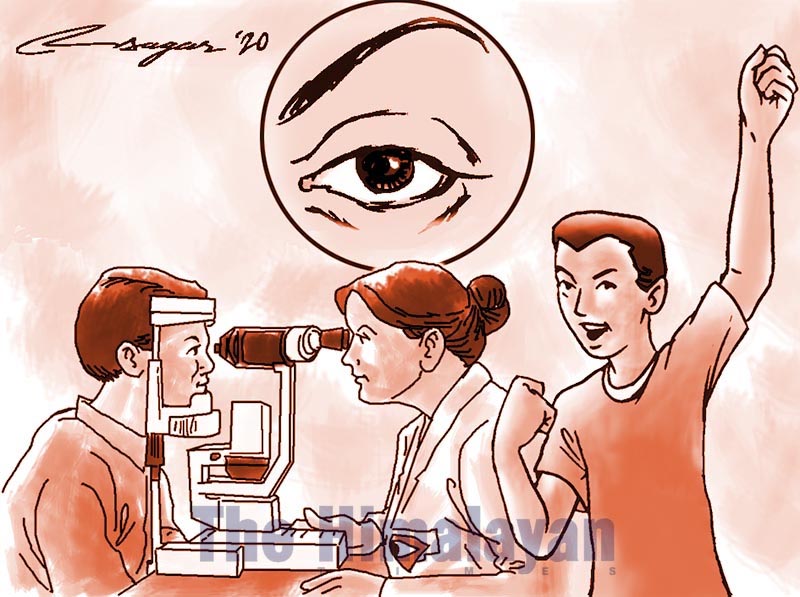Artificial eye: Boon for those with no eyeball
Many studies have shown that an ocular prosthesis has a significant role in psychosocial rehabilitation, employment and in regaining self-esteem. It generally lasts up to 7-10 years, with only occasional polishing, mending and adjustment needed
We have seen people with no eyes, which can be one-sided or both-sided. The condition of not having an eyeball behind the eyelids is called anophthalmia. Some people lack one or both eyeballs since birth. Sometimes the eyeball shrinks after a trauma. In many conditions, the eyeball is surgically removed in advanced cases of acute glaucoma or an ulcer in a clear cornea. The tumours developed within the eye can spread to other regions. So, in instances of intra-ocular tumours like retinoblastoma (most common childhood tumour of the retina), the eyeball should be taken out before it spreads.
We take care of the disease or pain after removing the eyeball, but certain things don’t ever leave thereafter. The mutilation disfigures the facial appearance permanently. If a child has no eye, then the adjoining organs also cease to develop properly, and in the long run facial symmetry might be largely disrupted. In such conditions, artificial eyes come as a boon to accentuate the outlook. They even keep the surrounding structures intact and natural.
There are, however, many misconceptions about artificial eyes. Some people presume that artificial eyes are donated by one person to another, which is not true. Donation of an eye is not a donation of an eyeball. It is merely a section of the cornea (the outer thin glassy layer of the eye) and is done only after death. Some may think that an animal’s eye can be put to make a non-eyed person see. This is also not true. Once an eyeball has been removed, there is no way a person can see.
Artificial eyes are not biological, they are made of plastic. Hence, we should know that inserting an artificial eye is not for making a person see, but for improving the cosmetic appearance. An artificial body part is called a prosthesis. In the same manner, an artificial eye is called an ocular prosthesis.
Artificial eyes are made up of polymer of acrylic plastic or silicon. They are durable and relatively resistant to flexure, temperature and scratches. Readymade prostheses can be found in almost all eye hospitals, and even in a few optical outlets. They cost from a few hundred to one thousand rupees. The client simply looks at the available choices of stock prostheses that closely match the fellow eye and makes a pick. The stock prostheses are just samples of the mass production made with general parameters and common colours. Finding a perfect match is almost like a nightmare, and we can do very little to improve their resemblance to the fellow eye.
Also, these stock prostheses might sometimes negatively affect the structural integrity of the lids and associated parts, resulting in unwanted symptoms, such as turning the eyelashes outwards and watering. So, it is always better to consult an ocularist, who specialises in custom fitting and fabrication of artificial eyes. The planning for making a customised prosthesis starts before the removal of the eye, and is often done in close coordination with an oculoplastic surgeon.
In Nepal, five eye centres provide ocular prosthesis services with the Tilganga Institute of Ophthalmology being the first, which started custom fitting in January 2012. The process of making ocular prostheses almost resembles the steps taken in making dental prostheses. It is due to this reason that dentists, or dental hygienists, were thought to be the right practitioners to refer the patients who needed artificial eyes. But that was when we had no ocularists in the country.
If the eye is white and not shrinking, we might choose prosthetic contact lenses or tattooing to save the integrity of the eyeball because when we insert the plastic eye over the compromised eyeball, it will further reduce the size by pressing. If the eye is shrinking or removed due to excessive sensation, we prefer a prosthesis. We can take an impression for making the mould for the new prosthesis over the dwindling eye or over the implant placed after surgical removal of the eye. The impression of alginate powder taken from the socket will serve as a mould to make a contour-matched acrylic eye.
Unlike readymade eyes, these eyes fit perfectly in the socket, with no hollows to serve as reservoirs for debris, discharge and micro-organisms. The contour alignment also facilitates greater motility, or ability to move around, as compared to readymade ones. The aesthetic values of artificial eyes are further enhanced by hand-painting the anterior surface with colours that match the other eye. Thin red threads are arrayed to masquerade the blood vessels. Finally, a three dimensional look is carved out after polymerising clear methacrylate (a class of “building block” chemicals used to make polymers and plastics that are stabile, durable, hard and scratch- resistant).
Unless there is discomfort or excessive discharge, there is no need to remove the prosthesis daily. When not worn, one can store it in a dry kit after cleaning with normal soap. While its lifespan largely depends upon handling and care, it generally lasts up to 7-10 years with only occasional polishing, mending and adjustment needed as advised by the ocularist. Many studies have shown that an ocular prosthesis has a significant role in psychosocial rehabilitation, employment and in regaining self-esteem and confidence.
Adhikary is an optometrist and Shrestha an ocularist






